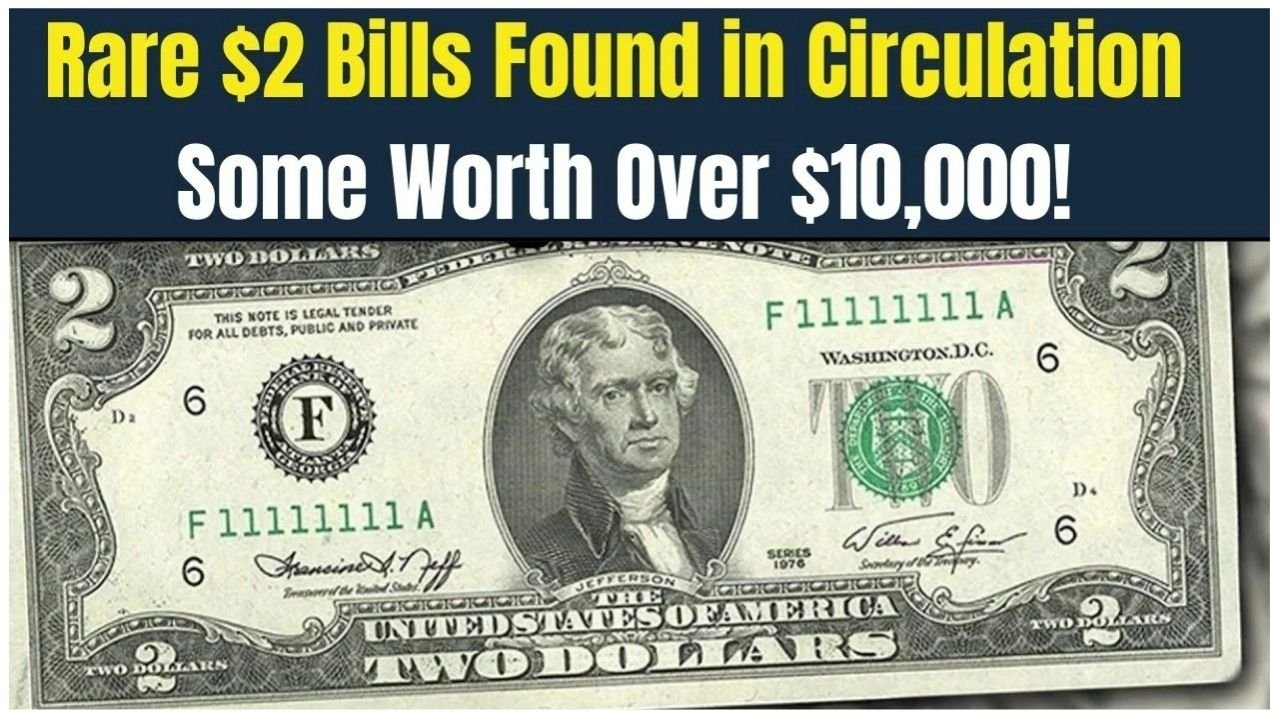For most Americans, the $2 bill is a quirky oddity, often pulled out during family gatherings as a novelty or tucked away in drawers as a lucky charm. (Rare 2 Dollar Bills) But what many don’t realize is that some of these rare $2 bills could be hiding a small fortune. In recent years, collectors have driven up the market for specific $2 bills, with some selling for thousands of dollars at auctions and private sales. Rare 2 Dollar Bills
So, what makes a $2 bill valuable? And could the one in your wallet or drawer be worth more than just its face value?
Let’s break it down. Rare 2 Dollar Bills
The History of the $2 Bill
Rare 2 Dollar Bills: First introduced in 1862, the $2 bill has had a rocky journey. Initially featuring Alexander Hamilton, then later Thomas Jefferson, the note was never as widely circulated as other denominations. The public saw it as unlucky or impractical, especially with slot machines and vending machines never designed to accept them.
Despite this, the $2 bill remained in limited production. Today, the Federal Reserve still prints them — the most recent series being from 2013 — but they remain scarce in daily transactions. Their low circulation and infrequent printing make them ripe for collectibility.
What Makes a $2 Bill Valuable?
A $2 bill’s value can soar due to a variety of factors: Rare 2 Dollar Bills
1. Series Year
Older series, especially those pre-dating 1928, are typically more valuable. Look for series years like 1862, 1890, 1917, and 1928.
2. Red Seals vs. Green Seals
Modern $2 bills (post-1976) have green seals, while older notes may feature red or brown seals. Red seal notes (especially from 1928–1963) are often highly sought after. Rare 2 Dollar Bills
3. Star Notes
A star symbol at the end of a serial number indicates a replacement note, which is rarer and can increase value significantly.
4. Low Serial Numbers
Collectors prize bills with serial numbers like 00000001, patterns (like 12345678), or “radar” numbers (palindromes like 1234321).
5. Printing Errors
Misprints such as off-center prints, inverted seals, or mismatched serial numbers can boost a note’s worth immensely.
Rare $2 Bills That Could Be Worth Thousands – Do You Have One? (Rare 2 Dollar Bills)
Valuable $2 Bills to Look Out For: Rare 2 Dollar Bills
Here’s a breakdown of some valuable $2 bills and their estimated market value based on condition and rarity:
| Series Year | Seal Color | Notable Feature | Est. Value (Avg. to High) |
|---|---|---|---|
| 1862 | Red | First $2 bill, Civil War era | $500 – $3,000+ |
| 1890 | Brown | “Treasury Note” | $1,000 – $4,500+ |
| 1917 | Red | Large size, ornate design | $300 – $2,000+ |
| 1928 Series A-G | Red | Small size, collectible | $20 – $500+ |
| 1953 Series A-C | Red | Red seal | $10 – $250+ |
| 1963 Star Note | Red | Rare star serial | $80 – $700+ |
| 1976 Star Note | Green | Bicentennial issue | $20 – $500+ |
| Fancy Serial # | Green/Red | Low or pattern serial number | $100 – $5,000+ |
| Misprint Note | Varies | Printing error | $200 – $10,000+ |
Don’t rush to a collector just yet. You might already have a gem in your possession. Here’s where you might find valuable $2 bills:
- Old wallets or family heirlooms
- Estate sales or auctions
- Coin and currency shows
- Your local bank (some still carry them upon request)
Pro tip: When requesting $2 bills from banks, ask for uncirculated bundles or check for older series years. You might just get lucky.
How to Determine the Value of Your $2 Bill
Valuing your bill requires attention to detail. Here’s how to do it:
Step 1: Examine the Series Year
Find this on the front of the bill, to the bottom right of Jefferson’s portrait.
Step 2: Inspect the Seal
Is it red, brown, or green? This can indicate age and rarity.
Step 3: Check the Serial Number
Look for star notes, patterns, or low numbers.
Step 4: Assess the Condition
Currency grading follows this scale:
| Grade | Description |
|---|---|
| Crisp Uncirculated (CU) | No folds, clean, sharp corners |
| About Uncirculated (AU) | Slight trace of handling |
| Extremely Fine (EF/XF) | Light folds, minimal wear |
| Very Fine (VF) | Moderate circulation signs |
| Fine (F) | Noticeable wear, still readable |
| Good (G) | Heavy wear, possibly damaged |
The better the condition, the higher the value. rare $2 bills
Step 5: Compare Market Prices
Use auction sites like Heritage Auctions, eBay, or currency-specific resources like Paper Money Guide.
Where to Sell Valuable $2 Bills
If you discover a potentially valuable note, here are the best ways to sell: Rare 2 Dollar Bills
- Certified coin dealers: Look for dealers affiliated with the American Numismatic Association (ANA).
- Online marketplaces: eBay, Heritage Auctions, and Great Collections often fetch high prices.
- Currency shows: Connect with collectors face-to-face.
- Social media collector groups: Facebook and Reddit have active communities for buying/selling notes.
Tip: Always get your bill appraised by a certified expert before selling.
Frequently Asked Questions (FAQs): Rare 2 Dollar Bills
Are $2 bills still in circulation?
Yes. While they are rarely handed out in change, the Federal Reserve still prints $2 bills. They are legal tender.
What is the most valuable $2 bill?
Some 1862 and 1890 large-size $2 bills can fetch more than $10,000, especially in pristine condition or with unique serial numbers.
Is a 1976 $2 bill worth anything?
Most 1976 $2 bills are worth face value unless they are in uncirculated condition, star notes, or have fancy serial numbers. Then, they can be worth $20 to $500.
What is a “star note”?
A star at the end of a serial number means the note replaced a misprinted one. These are produced in smaller quantities and are more valuable.
Can I spend a $2 bill at a store?
Yes, all $2 bills — regardless of series year — are legal tender in the U.S.

Rahul Sharma वर्तमान में SarkariEdu.info में एक अनुभवी कंटेंट राइटर के रूप में कार्यरत हैं। उनके पास डिजिटल मीडिया और लेखन का 6 वर्षों से अधिक का अनुभव है। वह मुख्य रूप से सरकारी योजनाओं, नौकरी अलर्ट्स, परीक्षा, रिजल्ट अपडेट्स और युवाओं से जुड़े करियर विषयों पर लेखन करना पसंद करते हैं। फिलहाल, वह प्रतियोगी परीक्षाओं, रिजल्ट, भर्ती न्यूज़ और शिक्षा जगत की ताज़ा खबरों पर केंद्रित होकर कंटेंट तैयार कर रहे हैं।
